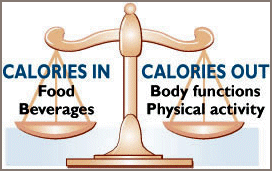
Balanced Nutrition – The rate at the resting state is referred to the term Basal Energy Expenditure (BEE) or Basal Metabolic Rate (BMR) – in simple terms, the energy needed to carry out fundamental metabolic functions, such as breathing, transporting ions, normal turnover of enzymes and other major body components. This energy needs can only be met through proper nutrition – a well balanced meal. This means that you should eat to replenish what the body has used up that day and to keep it going for the next day. When the body exerts energy, an appreciable amount of nutrients are used or lost and therefore, must be replaced. However, life itself must have a “balancing act.”
For example, all activities require energy from food to sustain life. Even the very common and simple way of living such as sleeping, breathing, snoring, eye blinking or when the body is at resting state – energy is still needed. The important thing to remember is that to achieve a healthy weight, there must be a good balance between the intake and output. Otherwise, the result is total imbalance.
Malnutrition – is the condition from lacking the nutrients from food resulting from unbalanced diet. Malnutrition –are carried in two different ways: undernutrition – is caused by inadequate intake of calories and protein; and overnutrition – is caused by unhealthy diets with excess intake of calories, fats, and refined carbohydrates.

Malnourished children may have stunted growth or may be short for their age, thin bodily structure or bloated stomach, and have weak immune systems. Those are classic examples of nutritional disorders. Nutritional disorders can affect any system in the body and the senses of sight, taste and smell. They may also produce anxiety, changes in mood and other psychiatric symptoms.

Another form of malnutrition that many couldn’t not imagine is Obesity. As mentioned earlier in previous pages that I believe that proper nutrition should start at early childhood. While we assume that because of life’s abundance the rich population receives their adequate nutrient needs. However, we must also need to know that many from this populate also suffer similar health problems like the poor. Majority of this group assumes that their knowledge of the importance of having food to eat suffices the need to live in the hierarchy of society. Unfortunately, many of them lack understanding of the very important factor of not only to be alive, but of health – and that is only achieved from adequate and balanced nutrient intake.
According to the latest data from the U.S. Centers for Disease Control and Prevention (CDC), the prevalence of obesity in children and adolescents aged 2 to 19 is 18.5% in the United States, that equates to 13.7 million American children. The Mayo Clinic reports indicate that Childhood obesity can cause pain and sometimes injuries in the hips, knees and back. Breathing problems and asthma are among the common problems in children who are overweight or obese. These children are also more likely to develop obstructive sleep apnea, a potentially serious disorder in which a child’s breathing repeatedly stops and starts during sleep. They may also develop early diabetes and cardiovascular diseases before they reach adult age.
Ofelia B. Mutia, MS.,RDN.,LD.
